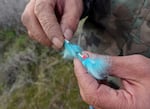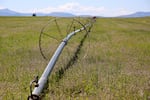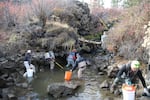Editor’s note: Throughout 2023 and into 2024, OPB is taking a deep look at the biggest social and economic challenges facing Oregon today – their origins, their impacts and possible solutions. This week, we’re looking at drought.
A beast of a truck rolled up to the usual meeting spot, a parking lot conveniently located between the highway and the river running through the Warm Springs Reservation in Central Oregon. Elke Littleleaf climbed down from the driver’s seat.
“Ready for your blindfold?” the fly fishing guide said, mostly joking.
Angling is a secretive business. On top of that, Littleleaf, a descendent of the Confederated Tribes of Warm Springs, often takes non-Indigenous clients along 39 miles of riverfront reserved for the Wasco, Warm Springs, and Paiute Tribes through treaty rights, where outsiders shouldn’t go uninvited.
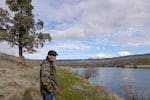
Elke Littleleaf visits what was formerly a favorite fishing spot on the Lower Deschutes River running through the Warm Springs Reservation on Feb. 2, 2024.
Emily Cureton Cook / OPB
“We already have a history of our treaties being broken, and broken, and broken,” Littleleaf said.
His business partner and wife rode shotgun. “My name is Klick’ump,” she said, “But my government name is Alysia Aguilar.”
The purpose of their big rig, a lifted ‘88 Suburban nicknamed “Silversquatch,” became clear as they turned off pavement and onto a rutted road, stopping at the end to survey a once-beloved fishing spot on the Lower Deschutes River.
“A lot of memories have been made here,” Aguilar said. “This is where I caught my first steelhead. It’s where many people caught their first fish.”
But the place on this February day doesn’t resemble those memories, not since recent wildfires burned the majority of the reservation’s riverfront.
“See that tree?” she said, pointing to ghostly limbs half-submerged. “This used to be a nice big tree that provided a whole bunch of shade, and steelhead would love to lay right underneath.”
All the big shade trees are gone now. Aguilar and Littleleaf don’t even bother casting here. They mourn the transformation as one of many losses linked to long-term drought. Severely dry summers bore down on most of Oregon four out of the last five years, worsening wildfires and water shortages. The U.S. Drought Monitor recorded some of the state’s most exceptionally hellish metrics in Central Oregon in 2021 and 2022. Across the western United States, scientists have coined the last two decades a “megadrought,” thought to be the driest time in the last 1,200 years.
“You just have to go with it,” Aguilar said. “You can’t control it.”

A green flag marks a cedar sapling planted in November 2023 by volunteers including Elke Littleleaf and Klick'ump, also known as Alysia Aguilar. The work is funded by a grant to restore this stretch of the Lower Deschutes River on the Warm Springs Reservation after wildfires.
Emily Cureton Cook / OPB
Along the burned section of river, she carefully stepped over the knee-high cedar saplings they planted in November. The couple spent years searching for money to do a restoration project like this. The funding finally came, but there was a catch: the source was a dam operator they blame for many of the river’s problems. That was a big compromise for a family of activists, who have protested pipelines, dams and corporations controlling natural resources. Faced with mounting threats to the ecosystems they rely on, Aguilar said they decided to do “whatever is necessary to get the work done.”
This type of pragmatism has a track record of restoring the Deschutes River Basin more broadly.
Many of the problems are familiar across Oregon and the West. Most of the river system is diverted to grow pastures and crops, and that’s still not enough to meet agricultural demand, with little left to support fish and wildlife.
And yet, as a megadrought grips the West, the Deschutes Basin has rebounded from dire straits in the early 2000s. Today, conservation measures are leaving 10 times more water in the river than was protected for Mother Nature in 2002.
Water planners in the basin say the credit largely goes to collaborations between potential adversaries, people who’ve been able to negotiate compromises, rather than fighting for control in court. This neighborly tone helped consolidate political willpower, winning tens of millions in federal funding to make agriculture vastly more efficient. Cities like Bend and Redmond have prioritized conservation to serve their growing populations, as a broad coalition looks to better scientific modeling to plan to offset dwindling water supplies. Still, a changing climate has the potential to force new conflicts, if Oregon fails to update its century-old water laws.
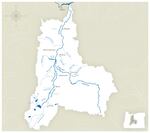
A map of the Deschutes River Basin, which geologists believe has been flowing a similar course for at least 7 million years, carving canyons on its way to meet the Columbia River, and eventually the Pacific Ocean.
Courtesy of Deschutes River Conservancy
OPB gathered progress reports from three of Central Oregon’s most notable water-saving initiatives, asking key players what they can teach the rest of the state.
Problem: Irrigation systems are inefficient and inequitable.
Deschutes solution: Big pipes save more for wildlife and farms to share.

In this handout photo from January 2022, workers inside a giant pipe used to modernize a main canal in the Central Oregon Irrigation District.
Courtesy of Kelley Hamby / Central Oregon Irrigation District
The water shortages in the Deschutes Basin started long before recent droughts. By 1913, developers had claimed every drop the river had to offer and then some. Today, irrigation districts deliver the lion’s share – diverting 86% of flows to canals near Bend and Redmond.
The canals crisscross more than 150,000 acres, greening the high desert’s farms, ranches, resorts and homesteads from April to October.
The system is wildly inefficient, with as much as half of the water in the open-air canals disappearing — evaporating, or seeping into the ground — before it reaches farmland.
Pressurized pipes offer a highly effective, if costly, alternative. Building them has long galvanized a coalition of tribal, agricultural and environmental groups. Over the last two decades, piping has conserved more water than any other conservation method on the river.
Recently, lawmakers punched the gas.
Since 2017, seven irrigation districts have racked up $138 million in federal funding. One of the largest recipients, Central Oregon Irrigation District, recently completed a major piping project for $33 million.
The COID project saves just a fraction — about 12% — of what the irrigation districts collectively say is possible to conserve through piping. That might not seem like a lot of progress, said COID Managing Director Craig Horrell, “but it’s like the snowball is starting.”
Having exact control over how water moves through the system will make it feasible for more landowners who don’t want the water to leave it in the river instead, he explained.
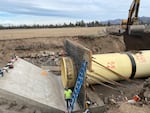
In this provided image, workers pipe a main canal for Central Oregon Irrigation District, March 23, 2023.
Kelley Hamby / Central Oregon Irrigation District
Horrell did not see this milestone coming 10 years ago. The district users hold some of the most senior water rights to the river, dating back to 1900. Through a state system replicated across the West, the lands attached to the oldest water rights are first in line during dry times, giving their owners little incentive to change.
For more than a century, Oregon’s system of “prior appropriation,” often referred to as “first in time, first in right,” has distributed water based solely on the age of water rights.
“I always say, it’s like my grandfather started his business before your grandfather,” Horrell said.
The rights are actually state permits authorizing people to use a certain amount and source of water in a particular place, and they’ve become wed to private property values.
In 2014, new federal protections for an endangered species — the Oregon spotted frog — shifted century-old dynamics.
Legal requirements to stave off the frog’s extinction coupled with droughts meant farmers with junior water rights stood to lose everything. What’s remarkable about this conflict, Horrell said, is how the senior and the junior irrigation districts are navigating it. In 2017, they hammered out an agreement meant to save water for junior farms, largely by sharing what’s conserved through piping canals.

An Oregon spotted frog floats in an irrigation canal in this photo from July 27, 2016. The frogs have lost nearly 90% of their historical range.
Brian Feulner / Pacific Legal Foundation
Recent droughts have tested this goodwill, as even senior irrigators have gotten far less water than they’re entitled to on paper.
“We’re sitting here trying to be good partners, knowing that one has the rule of law in their corner,” Horrell said. “At the end of the day, we all keep showing up for each other. And that is something that you don’t see anywhere in other basins.”
Problem: Fish and wildlife are last in line for water.
Deschutes solution: Buying or leasing water rights for Mother Nature.
“Fun fact about Oregon,” Kate Fitzpatrick began wryly, as she explained how state law didn’t consider flows for fish and wildlife a “beneficial use” of water until 1987.
“Before then, there was no way to protect water in the river,” continued the executive director of the Deschutes River Conservancy, a nonprofit formed to raise streamflows and improve water quality on its namesake river.
By the time Oregon lawmakers passed a bill allowing state agencies to protect streams through the water rights system, most rivers were already spoken for beyond the reality of what Mother Nature provides. The same seniority system that puts landowners with claims from 1900 ahead of those from 1913, also pushes fish and wildlife to the very back of the line.

In this provided photo from 2018, a redband trout navigates a riffle of the Deschutes River.
Courtesy of Arian Stevens Photography
“Those [in-stream] water rights had priority dates of the 1980s, so they were never met, ever,” Fitzpatrick said.
Her organization specializes in a workaround: Paying people with older water rights to leave them in the river, either through outright purchase, or temporarily leasing for as long as landowners are willing.
About half of the conservancy’s budget comes from state and federal grants, with the other half being private donations. Its programs to lease or buy water rights have restored more than 15 billion gallons a year to the Deschutes Basin. That’s roughly equivalent to the amount of water saved through piping projects, and still a small fraction of how much goes toward irrigation.
This approach won’t work in every place in Oregon facing drought. “The tools will vary wherever you are,” Fitzpatrick said, “But collaboration is really the heart and the foundation of it.”
The conservancy decides which solutions it’s going to pursue by requiring unanimous support from a board of directors with representatives from farming, ranching, timber, development, hydro-power, recreation, tribes and environmental groups.
This moves slowly, she said, but “it’s arguably the quickest way to make progress.” She measures that progress by how much more water is in the river now, versus 20 years ago, and “the community cohesion around it.”
Fish and wildlife have also benefited, like the steelhead, Chinook salmon or redband trout returning to certain tributaries of the Middle Deschutes Basin that used to run almost dry most summers. Fitzpatrick acknowledged that shriveled streamflows, habitat destruction and pollution are still huge challenges, but “absent this work, however slow it may be… It could be an absolute crisis.”
Problem: A city that will outgrow its water supply.
Deschutes solution: Conservation, and a political push
There’s a particular home in Redmond that the city’s water manager keeps tabs on.

A street view of the Redmond yard that homeowner Cory Holmes says one of his neighbors "wasn't happy about."
Emily Cureton Cook / OPB
The brilliant green yard stands out in a mostly brown neighborhood. The homeowner, Cory Holmes, said his next door neighbor is jealous of his “perfect yard.”
The city water manager, Josh Wedding, usually checks on Holmes’ house from afar, using a computer in his office to see exactly how much water any address in the city consumes. But on a recent day, Wedding drove by the intensely green lawn to admire it in person.
“Here’s the astroturf yard,” he said proudly. “Their water use is minimal and it doesn’t change.”
He looked across the street approvingly at other homes with small yards covered in rocks, succulents and drought-tolerant shrubs, all backing up to an alley of shared grass.
“This subdivision is my ideal. I think this is aesthetically pleasing, and I can tell you this entire subdivision uses very little water,” Wedding said.
Holmes said he just doesn’t like to mow, or deal with sprinklers. As one of many newer residents in the fast growing city, he wasn’t aware of its water issues, or of Wedding’s vision for a Redmond with more parks and a lot less grass in people’s yards. Last year, the city changed its code to limit grass around new developments. The school district recently converted its sports playing field to artificial turf. Every water department employee gets notified – by email and text – whenever remote sensors detect a leak in the system. Next, Wedding hopes to implement tiered rates, where “you pay more based on the water that you use.”
“You start combining that together and it adds up to a lot of water savings,” he said.
The cities in Central Oregon — Redmond, Bend and Prineville — primarily rely on groundwater. They collectively account for less than 5% of all the water people use in the region, but have the most stringent conservation practices. And Redmond is planning for an unreliable future. All the city’s water gets pumped out of the ground, from the same aquifer that recharges springs feeding the lower Deschutes River. State scientists believe the groundwater is largely declining because of a changing climate, and because more people are pumping it out. Regulators are considering a statewide ban on new wells in certain places.

City of Redmond Public Works Operations Manager Josh Wedding views the site of a newly constructed well in February 2024 that he believes will meet the city's water demand through 2040. After that, the city's water supply is on uncertain ground with state regulators.
Emily Cureton Cook / OPB
This worries Redmond leaders. The city of 38,000 could exhaust its current water rights by 2040, when officials predict it will have 54,000 residents. Its recent application to drill more wells got a chilly reception. In December, a state hydrogeologist found the city’s proposal was “not within the capacity of the resource.”
Mayor Ed Fitch argues the city’s rapid growth, a state mandate to build more housing, and conservation practices should weigh in Redmond’s favor, because the city needs to have certainty around water access.
“It’s not just housing,” Fitch said. “How can you attract a business and say, ‘We might give you water now, but we’re not sure about 10 years from now.’ Who would invest in that? Nobody.”
Throughout Redmond’s negotiations with state water regulators, Fitch said he was aware of “kind of an elephant in the room.”
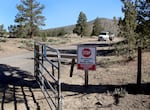
A truck loaded with construction materials leaves the Thornburgh destination resort site in Deschutes County, Ore., in June 2022.
Emily Cureton Cook / OPB
The elephant is a proposed golf course resort near the city, Thornburgh. Its developer also wants to drill wells, but last year one of its applications got the same treatment as the city’s. The situation raises thorny questions state lawmakers have long avoided about the value of water, and which ways to use a limited resource should get priority.
“I think cities have a more important role in the whole future of the region,” Fitch said. “There has to be a recognition of that duty, that responsibility, and how do we best make that fit with the current conditions of the aquifer?”
State law doesn’t discriminate between so-called beneficial uses, which means booming cities, farmers growing food, luxury estates, private water ski lakes, and golf course resorts all carry the same weight.
“I have no confidence in drought easing,” the irrigation district manager Horrell said. “We have to be proactive in attacking how we do our business to be better.”
To environmental advocates like Tod Heisler, it’s the water rights system, not drought, causing water shortages in the state.
“Every year is a drought year for fish and wildlife. Now that it’s affecting people we have a crisis. We’ve had a crisis for a long time,” said Heisler, a consultant for the watchdog group Central Oregon LandWatch.
Thus far, solutions in the Deschutes Basin have largely focused on working around state laws. For instance, people who don’t use the full amount of water they’re entitled to risk losing it forever. While this very rarely happens, the mere threat strongly discourages conservation, Rep. Ken Helm, a Democrat representing Beaverton and Cedar Hills, told OPB in a 2021 interview.
Changing the rule, though, has been a political non-starter for decades.
“It would be a bloodbath in the legislature,” said Helm, who serves as chair of the House Committee on Agriculture, Land Use, Natural Resources and Water.
Systemic overhauls would mean telling Oregon’s powerful agricultural interests that they have to cut back, which could be economically devastating for rural communities. Lawmakers have instead focused on funding more efficient infrastructure, better scientific data, and locally-driven planning efforts.
“Optimism is represented by those groups convening and sticking with the conversations,” Helm said.
The Deschutes Basin is widely seen as a poster child for water collaborations.
But, at a certain point, compromises aren’t enough, said Warm Springs fishing guide Aguilar, who doesn’t represent the tribal government’s views.
In 2015, she went to the protests to stop a bottled water behemoth, Nestlé, from buying up water rights and building a plant in the Columbia River Gorge. A groundswell of opposition from Columbia River tribes energized backlash to the project, and in 2017, then Gov. Kate Brown took a decisive step toward shutting it down.
“To have all that happen was such a big win. Eyes opened up. It peeled pride open. Like, you’ve got to fight, you’ve got to get up, you’ve got to be a voice,” Aguilar said.
The reservation she calls home occupies a tiny fraction of her tribes’ ancestral lands. She said it’s hard to be polite and smile when clients who come to fish and have fun are taken aback by the area’s natural beauty, and they say things like: “Oh, ‘You’re so fortunate,’ or ‘You’re so lucky to have this.’”
“This is what little we barely have left, this reservation that’s burnt and scorched to death,” she said. But, after years of guiding, primarily for older white men, she’s learned to focus on common ground — most people come to the river to feel more attuned to nature, and to let go of whatever’s getting them down.
“A lot of people come to the river for that connection, and for healing. We’ve done so much healing out here ourselves. We all need it. We can’t live without it.”
Then, she fell silent for a long time, as she listened to the river.

Klick'ump, also known by Alysia Aguilar, and Elke Littleleaf say they try to impart the urgency of the need to change water management to both their fly fishing clients, and their own family: "With our kids, it's like they don't believe us when we say we need to go salmon fishing, because there might not be any left." Feb 2. 2024.
Emily Cureton Cook / OPB
This story was written and reported by Emily Cureton Cook, edited by Ryan Haas, and produced for the web by Meagan Cuthill, with photo editing by Kristyna Wentz-Graff. This series exploring both the biggest problems facing Oregon and potential solutions is sponsored by the Oregon Community Foundation. None of OPB’s journalism happens without you. Help us tell more stories like this one — and ensure stories like this reach as many people as possible — by joining as a Sustainer now.


